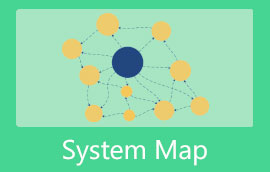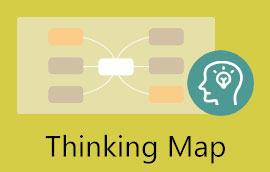如何使用 MindOnMap 製作音樂歷史時間軸模板
與我們一起踏上令人興奮的旅程 音樂史年表,探索其在不同文化中的根源。從古老的部落節奏到現代 DJ 曲調,音樂一直是人類生活的重要組成部分,它觸動我們的情感,促進團結,反映我們的價值觀和夢想。我們的時間表將成為您了解音樂演變的關鍵,突顯影響當今音樂格局的重大事件、著名藝術家和趨勢。我們將研究不同音樂流派的起源、塑造它們的文化,以及徹底改變音樂創作、聆聽和享受的技術。

第 1 部分:如何繪製音樂歷史時間軸
音樂時代時間表有助於了解事件和想法之間的聯繫,這對於理解音樂歷史非常有用。它清晰地展示了重要事件、有影響力的人物和文化影響。在本指南中,我們將向您展示如何使用以下命令製作音樂歷史時間表 MindOnMap,它允許您添加圖像和視頻。 MindOnMap 可以製作不同類型的圖表,包括時間線,並且可以輕鬆更改以滿足您的需求,使其非常適合組織複雜的音樂歷史資訊。首先按順序列出重要的音樂史事件。強調音樂風格和藝術家如何相互影響。添加圖像、聲音和視訊等多媒體,使其更有趣。我們還將幫助您添加更多詳細資訊、連接它們並更改時間軸的外觀。
在瀏覽器中搜尋 MindOnMap 並開啟網站。點選“流程圖”按鈕以建立新專案。

選擇左側面板上的“文字”按鈕以新增標題。之後,您可以新增一條線和項目符號點來突出顯示每個時間軸。
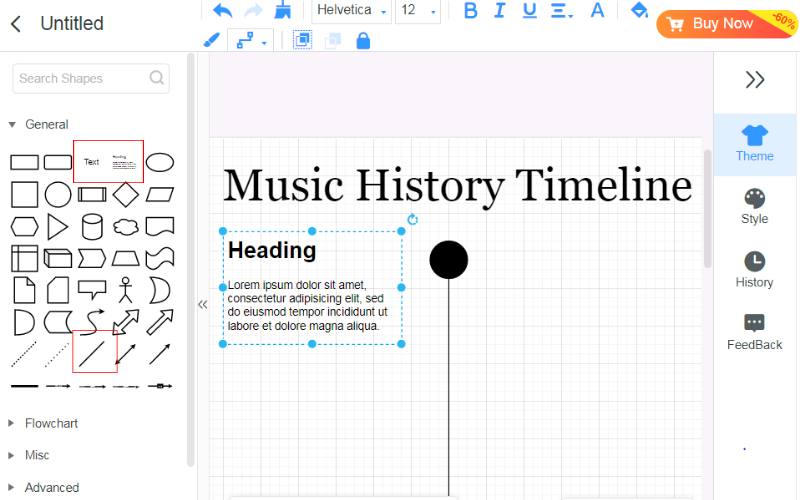
重複步驟 2 的過程。

製作草稿後,如果您想要協作,可以與團隊成員分享連結。只需點擊網站右上角的共享圖示即可。
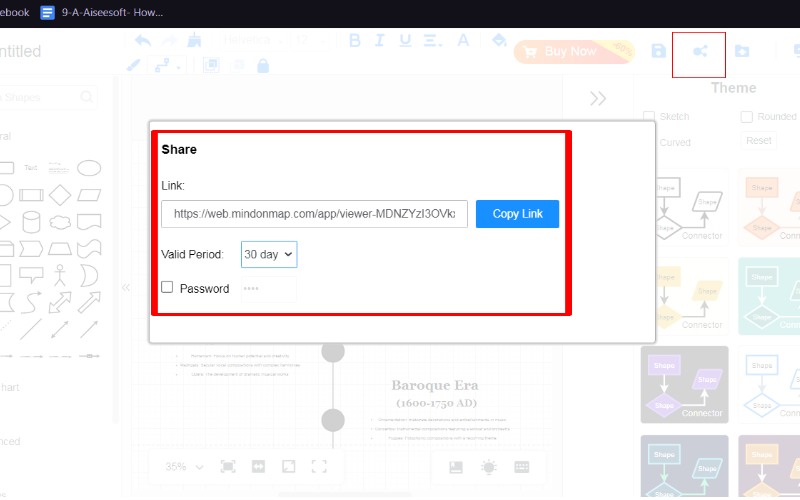
作為最好的心智圖創建者之一,它不僅可以讓您創建音樂歷史時間,還可以創建 蜘蛛圖、樹形圖、腦力激盪心智圖等。
第 2 部分:音樂時期時間軸說明
音樂時間線是一個複雜的話題,涵蓋數百年和世界不同地區。它就像是一幅展示重要事件、音樂家以及音樂如何變化的圖片。它可以幫助您了解不同類型的音樂如何相互聯繫以及它們如何相互影響。
以下是您可以在音樂歷史時間軸上找到的一些主要內容:
古代: 第一種用於儀式、儀式和故事的音樂。
中世紀時期: 格里高利聖歌、吟遊詩人和多聲部音樂的開始。
文藝復興時期: 人文主義的興起、牧歌的開始與歌劇的創作。
巴洛克時期: 使用精美的裝飾、協奏曲和複雜的音樂作品。
古典時期: 注重結構和形式,與莫札特、海頓和貝多芬等著名作曲家合作。
浪漫時光: 音樂都是關於情感、音樂故事以及蕭邦、李斯特、華格納和布拉姆斯等作曲家的。
20世紀: 嘗試新事物並勇於創新,例如爵士樂、藍調、搖滾樂、古典音樂,以及史特拉汶斯基、荀貝格和伯恩斯坦等作曲家。
21世紀: 數位音樂、來自世界各地的音樂、新的音樂風格以及科技如何改變音樂。
透過查看音樂歷史時間表,您可以了解:
• 不同類型的音樂是如何開始並隨著時間的推移而變化的。
• 文化、社會和歷史如何影響音樂。
• 音樂家和作曲家在歷史上的重要角色。
• 新科技如何影響音樂世界。
• 對於學生、音樂愛好者以及任何想要深入了解豐富多彩的音樂世界的人來說,良好的音樂歷史時間表可以成為一個很好的工具。
第 3 部分:獎勵:音樂流派時間線
在了解音樂史後,我們將研究音樂流派的時間線及其變化。在這一部分中,我們將向您展示如何使用 MindOnMap 創建音樂時間線,以了解流派如何相關、它們從哪裡開始以及重要人物是誰。
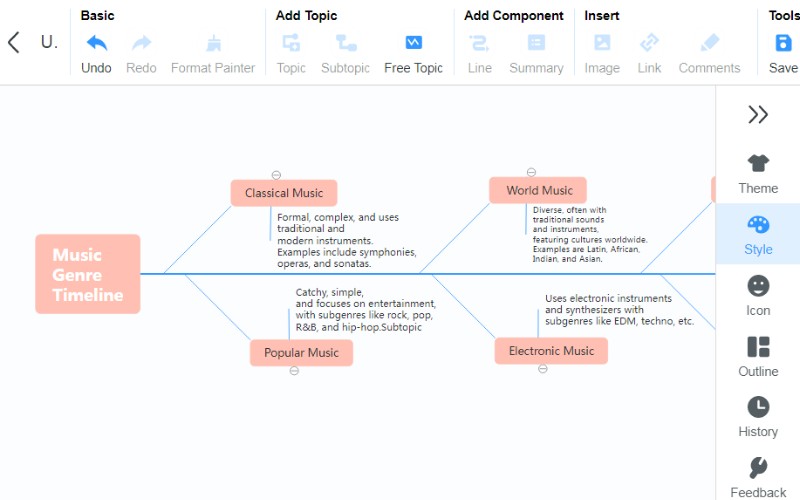
什麼是音樂流派?
音樂類型是根據音樂的聲音(例如速度、節拍、曲調、和聲以及使用的樂器類型)對音樂進行分類的大群體。透過製作音樂流派時間表,您可以了解流派如何相互聯繫、回溯到它們的起點,並了解它們多年來如何發展。
古典音樂: 正式、複雜,使用傳統和現代樂器。例子包括交響樂、歌劇和奏鳴曲。
流行音樂: 朗朗上口、簡單、專注於娛樂,包括搖滾、流行、R&B 和嘻哈等子流派。
世界音樂: 多樣化,通常具有傳統的聲音和樂器,具有世界各地的文化特色。例如拉丁語、非洲語、印度語和亞洲語。
電子音樂: 使用電子樂器和合成器以及 EDM、techno 等子流派。
民樂: 具有簡單旋律和原聲樂器的傳統音樂。它包括民謠、藍調和藍草音樂。
爵士樂: 即興創作、切分音以及非洲和歐洲風格的混合,以及波普和融合等子流派。
搖滾樂: 電子、節奏感和活力,包括搖滾、金屬和龐克等子流派。
嘻哈音樂: 節奏節拍、饒舌和取樣,以及黑幫饒舌和陷阱等子流派。
鄉村音樂: 簡單、說故事,通常是原聲音樂,有鄉村和藍草等子流派。
流行音樂: 朗朗上口、簡單且商業化,有流行、流行搖滾和青少年流行等子流派。
R&B(節奏藍調): 藍調、爵士樂和福音音樂的融合,還有靈魂樂和放克等子流派。
第 4 部分:如何繪製音樂史的常見問題解答
什麼音樂流派最早出現?
要找到第一個音樂流派很困難,因為音樂已經存在很久了。我們了解古代樂器和風格,但新音樂類別的想法是後來才出現的。藍調是最早流行的音樂風格之一,後來催生了搖滾樂、爵士樂和 R&B 等其他音樂風格。
世界上第一位歌手是誰?
沒有人確切知道歌唱是什麼時候開始的。這是人類表達自己的常見方式,很久以前就開始了。我們可以透過歌曲和故事將歌唱追溯到早期文化。
音樂的八個時代是什麼?
音樂史分為八個時代:古代時代、中世紀時代、文藝復興時期、巴洛克時代、古典時代、浪漫主義時代、20世紀和21世紀。每個時代都有不同的音樂風格、流派和影響,反映了當時的文化、社會和技術發展。
結論
這 音樂時代時間表 顯示了其廣泛的範圍、增長以及對不同文化和時代的影響。從部落鼓到現代 DJ,音樂一直是感受、連結和展示重要事物的一種方式。我們研究了音樂如何變化、重要的人物和風格,以及科技如何改變音樂。了解音樂史有助於我們理解和享受今天的音樂以及未來的音樂。讓我們繼續探索並創造音樂,讓歷史永存。









